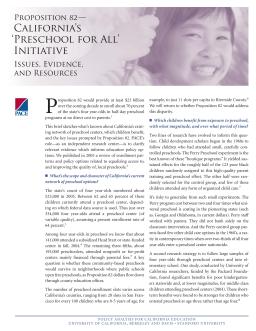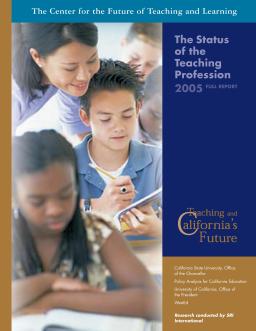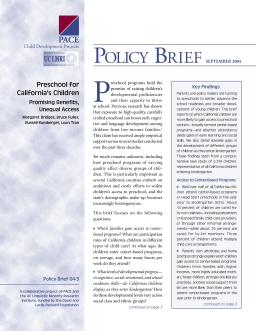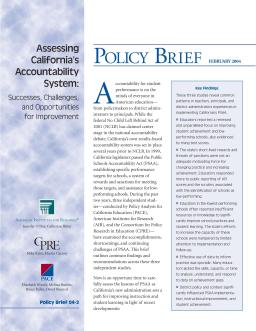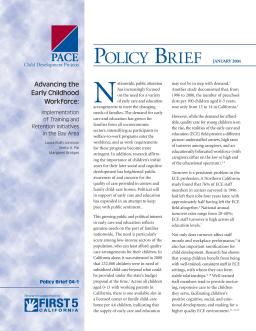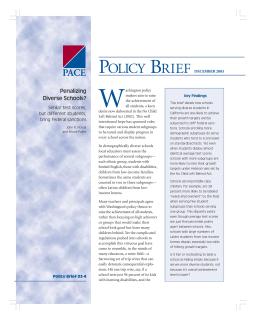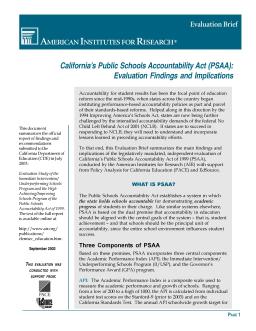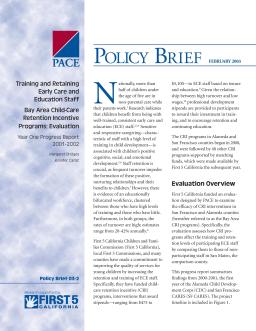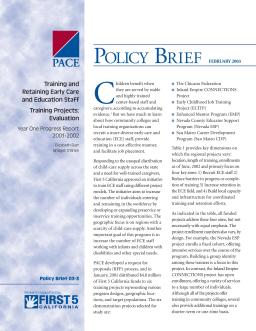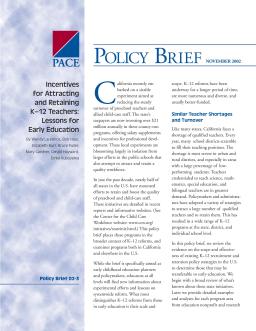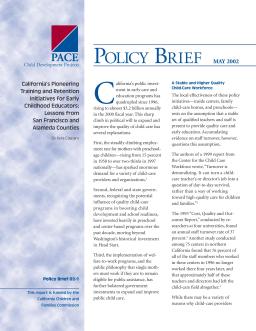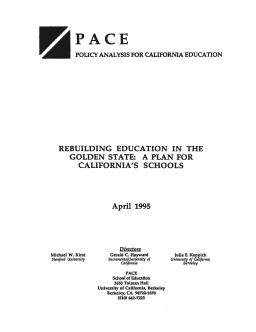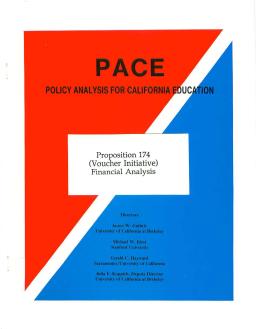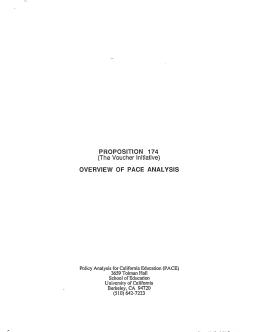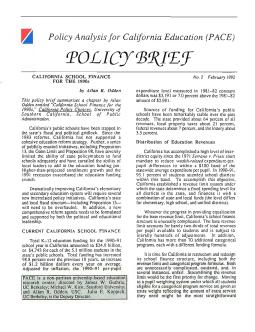Issues, Evidence, and Resources
Published
Summary
This policy brief provides an overview of California's existing network of preschool centers and the potential impact of Proposition 82, which would provide funding for half-day preschool programs for 70% of the state's four-year-olds. PACE, an independent research center, aims to clarify evidence informing education policy options. A 2005 PACE review focused on enrollment patterns and policy options for improving access and quality of local preschools.
Full Report
Published
Summary
The Teaching and California's Future initiative provides policymakers with data on the teacher workforce and labor market. The initiative's annual report details teacher development policies and their impact on teacher quality and distribution. The goal is to help policymakers make informed decisions about strengthening the state's teacher workforce.
Published
Summary
The quality of teaching and the need to expand California's ranks of excellent teachers demand urgent public discussion. We must attract the best and brightest to teaching, prepare them effectively, and support and retain them. Solutions require bipartisan leadership, not spin. This report presents the latest research and projections, highlighting that while some numbers are improving, we're likely to face severe shortages again soon and the pipeline for recruiting, preparing, and training teachers has substantial problems.
Promising Benefits, Unequal Access
Published
Summary
This policy brief examines how California's education governance has shifted from local control to centralized, administrative accountability over the past 30 years, including changes in school finance. It primarily focuses on categorical program funding, assessing its impact on equity, adequacy, flexibility, choice, efficiency, predictability, stability, rationality, and accountability. The authors also propose alternative models to the existing system of categorical funding.
Successes, Challenges, and Opportunities for Improvement
Published
Summary
California's accountability system, PSAA, has been examined by three independent studies, revealing five key issues. The system established specific performance targets, rewards, and sanctions for schools, but budget constraints and differences with NCLB require changes. The STAR testing and school assessment system needs review, and Governor Schwarzenegger proposed simplifying the school finance system. The brief aims to inform policymakers, clarify complex accountability issues, highlight educators' views, and outline four major implications.
Implementation of Training and Retention Initiatives in the Bay Area
Published
Summary
The early care and education (ECE) profession faces staffing problems due to understaffed centers, high turnover rates, and an educationally bifurcated workforce. To mitigate this issue, programs like the California Childcare Retention Incentive (CRI) provide monetary stipends to ECE professionals who meet tenure and education requirements. This policy brief summarizes findings from a two-year evaluation of CRI programs in Alameda and San Francisco counties, focusing on themes relevant to Year 2 implementation.
Similar Test Scores, but Different Students, Bring Federal Sanctions
Published
Summary
California schools with more demographic subgroups are less likely to meet their growth targets and face federal sanctions, even when students have similar average test scores. Schools with many low-income Latino students are particularly unlikely to hit growth targets. Is it fair to label diverse schools as failing when their overall achievement level is not necessarily lower?
Evaluation Findings and Implications
Published
Summary
This report evaluates California's Public Schools Accountability Act of 1999, which aimed to hold schools accountable for student results. The brief summarizes the main findings and implications of the legislatively mandated, independent evaluation of the Act, with the aim of helping states understand and learn from preceding accountability efforts.
Bay Area Childcare Retention Incentive Programs Evaluation—Year One Progress Report, 2001–02
Published
Summary
The First 5 California Children and Families Commission has funded the Childcare Retention Incentive (CRI) to improve the quality of early care and education (ECE) staff training and retention. An evaluation funded by First 5 California assesses the efficacy of CRI programs in San Francisco and Alameda counties. This report summarizes the preliminary findings from the first year of the Alameda Child Development Corps and San Francisco CARES programs, which examine whether CRI recipients are more likely to participate in training and be retained compared to non-participating ECE staff.
Year One Progress Report, 2001–2002
Published
Summary
This policy brief examines the effectiveness of childcare retention incentive (CRI) programs in selected California counties. It assesses program design, participant characteristics, training activities, and retention rates among early care and education staff. The study aims to identify the impact of CRI programs on the stability and training of the ECE workforce, which is critical for improving the quality of care for children.
Evaluation Year One Progress—Report 2001–02
Published
Summary
First 5 California approved an initiative to train early care and education (ECE) staff in regions with a scarcity of childcare supply. Six training projects were selected, which provide community college training and additional training on a shorter-term or one-time basis. The goal is to increase the number of individuals entering and remaining in the ECE workforce and to increase the number of ECE staff working with infants and children with disabilities and other special needs.
Lessons for Early Education
Published
Summary
This policy brief discusses state initiatives in the US aimed at retaining and improving the quality of preschool and childcare staff, with a focus on California's $21 million annual investment. While K-12 reforms have been underway longer and are usually better-funded, early childhood education policymakers and educators will find valuable information about experimental efforts and lessons on systemwide reform.
California Families See Little Growth in Child Care Centers
Published
Summary
The rise in the number of working mothers has led to a greater need for childcare, and investments have been made to support early education. California's childcare programs have seen a surge in funding, including a tax credit program. The policy brief aims to explore if the increased funding has improved access to quality childcare centers and preschools for California families.
Lessons from San Francisco and Alameda Counties
Published
Summary
The policy brief discusses the reasons behind California's increase in public investment in early care and education programs, including the rising demand for childcare, recognition of the potential benefits for child development and school readiness, and the implementation of welfare-to-work programs with results and insights from both San Francisco and Alameda Counties.
New Lessons for Los Angeles
Published
Summary
California is experiencing a shortage of quality childcare options for families, despite increased funding from the government and parents. Local policymakers in Los Angeles County are conducting research to determine where childcare supply falls short of demand and how to allocate resources to address the issue. Two recent studies provide options for policymakers to consider.
Local Innovations Help Working Families
Published
Summary
Many low-income families struggle to afford childcare, even with financial supports. Less than one-fourth of eligible families sign up for subsidies in many communities, leading to disparities in access. The What Works series examines effective programs and policy strategies to increase participation in childcare subsidy programs. The report draws from the Growing Up in Poverty Project, which found highly variable rates of eligible parents using childcare subsidies across CA, CT, and FL. Possible reasons for low utilization and present novel strategies to increase participation are discussed.
Published
Summary
Governments are expanding the availability of portable child-care vouchers to boost working parents' purchasing power, rather than simply building more child-care facilities. Despite this, parents in poor communities still have limited choices due to cost and supply. Many eligible parents are not using subsidies, resulting in high out-of-pocket expenses for child care. Low-income working mothers make tough choices, working more hours or relying on informal providers, resulting in several transitions for children throughout the week, which experts suggest is not good for young children.
Published
Summary
This study examines student mobility in California, particularly at the secondary level. It investigates the incidence, consequences, and causes of non-promotional school changes and offers strategies to address the issue. It also draws on an extensive dataset from various sources, including surveys and interviews with California students, parents, and schools. The findings highlight the negative impact of student mobility on educational achievement and suggest that families, schools, community agencies, and policymakers should take action to mitigate its harmful effects.
A Plan for California’s Schools
Published
Summary
In 1990, PACE issued a plan for CA schools, addressing the challenges of explosive growth, increasing diversity, and lagging student achievement. Five years later, PACE has revised the plan to include measurable statewide education goals, a new student assessment system, teacher education reforms, and the goal of English proficiency for all students. Other recommendations include school finance reform, coordination between schools and social services, evaluation of local reform efforts, experiments to improve student achievement, and linking school-to-career policy with education reform.
Financial Analysis
Published
Summary
The Californians will vote on Proposition 174 which will amend the state constitution to establish "scholarships" for kindergarten to 12th-grade schooling. These new schools will be publicly funded but may have privately selected governing boards and religious orientation. It is unclear whether they will be public or private schools. The paper attempts to reduce uncertainty regarding the financial consequences of the proposed voucher plan and address questions about public costs and possible cost savings.
Overview of PACE Analysis
Published
Summary
Policy Analysis for California Education (PACE) has analyzed the financial, legal, and social ramifications of Proposition 174, the school choice initiative, to provide Californians and policymakers with accurate, unbiased information. This brief contains important questions and answers about the initiative, summaries of PACE's financial analysis and polling report, and background information on PACE and its directors. PACE has published five separate analyses of Proposition 174, covering financial impacts, legal considerations, public opinion, and comparisons with other school choice efforts...
The School Voucher Initiative
Published
Summary
The "Parental Choice in Education Initiative" or Proposition 174, will be voted on by Californians on November 2, 1993. PACE has conducted an analysis of the initiative's provisions to provide objective information to policymakers, parents, educators, and the public. PACE is not taking a stance on the initiative but has produced additional materials related to the initiative and the issue of school choice. These materials are listed in the attached report on school choice.
Published
Summary
California's education reform strategy includes creating high-quality curriculum frameworks to upgrade K-12 education, which raise expectations for students' knowledge and understanding of language arts, mathematics, science, and history/social science. The frameworks focus on learning for understanding, problem-solving, and applying knowledge to real-life situations. The goals are to produce students who know how to learn, analyze issues, solve problems, and apply their knowledge to real-world problems.
Published
Summary
California's public school student achievement is improving but still has a ways to go to meet world class standards. Increasing enrollments, declining revenues, and political issues are distracting from education reform. This policy brief seeks to bring attention to building public visibility and political consensus around national strategies for accelerating education reform. The message is not that California's public education system will be subordinated to a monolithic national reform effort.
Published
Summary
California's education system has suffered from a lack of cohesive reform strategy since 1983 due to political and fiscal gridlock, and initiatives like Proposition 13 have limited state and local leaders' ability to fund schools adequately. To improve the system, California needs to overhaul its fiscal structure and formulate a new comprehensive reform agenda with the support of both political and educational leadership.
